M
Leave a Legacy of Giving
You can support our mission of changing lives by saving sight in multiple ways!
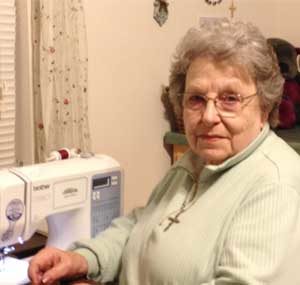

With her vision restored by cornea transplantation, Dorothy is able to continue volunteering for her local hospital.
Dorothy was born and raised in Washington, Missouri. Not only has she lived her entire life in Washington, but she spent a considerable portion of her time working in the town’s hospital, what is today known as Mercy Hospital Washington. Dorothy first worked as a nurse’s aide during World War II and later went on to become the hospital’s executive housekeeper for 28 years. In fact, she even met her husband of 68 years through the hospital.
“I met [my husband’s] mother at the hospital, and he was in the service,” Dorothy said. “She asked me to start writing to him, so I did and now we’re still married.”
It comes as no surprise then that, after her retirement, Dorothy has stayed involved with the hospital as part of the auxiliary club. But what did come as a surprise was her rapidly failing eyesight a few years ago. “I had to use magnifying glasses just to read, which was strange because I hadn’t had a problem before,” said Dorothy. “It kept getting worse and worse, so I got stronger magnifying glasses.” When she could no longer find a magnifying glass strong enough to help her read, she visited a doctor. “He said my eyesight was really bad and asked if I wanted to keep seeing my grandchildren,” she said. Dorothy was diagnosed with Fuchs’ dystrophy, a disease that causes an inner part of the cornea to blister and cloud. “The doctor said I needed corneal transplants,” she said. “I wasn’t ready for that, but if I waited any longer, I’d be blind.”
Dorothy visited Dr. Fedyk, an ophthalmologist in St. Louis, who performed a few laser surgeries first to try to fix her vision without transplantation. But eventually it became clear that Dorothy would have to undergo corneal transplant surgery. “I was upset about it, but I knew I wouldn’t be able to see otherwise,” said Dorothy. “Dr. Fedyk scheduled the appointments, and I just did exactly what he said to a T and it was really good. You have to have patience and do what you’re told. The hospital was great, everything was so perfect for me.”
The corneal transplant surgeries were successful. “After I could see, it was amazing,” said Dorothy. “It was like a gift—well, it was a gift from the people who donated the corneas.” Because of her many years of experience in a hospital, Dorothy understood that her transplant tissues were donated by other people who chose to be donors when they passed away. “After my transplant experience and knowing other people’s experiences, I just think it’s a blessing that people will donate organs and tissues,” she said. “At first I couldn’t understand it, but then I saw how donation helps people so I think it’s wonderful. I can’t believe how it’s helped me. I want to encourage more people to donate.”
Dorothy has reported having terrific vision and can even read without glasses. “Before, there was a film over everything,” Dorothy remembered. “It was like walking in a fog–everything was blurred. I used to love to read and got upset when I couldn’t.” Thanks to two heroic cornea donors, Dorothy can see well again and read comfortably. “I can’t believe how much I was missing,” she said. “The colors are just beautiful, it gives you a beautiful outlook on life. I enjoy seeing people clearly again.” These days, Dorothy puts her renewed vision to good use by volunteering her time for the hospital. In fact, her sight is so good that she sews pillows for the maternity ward at Mercy Hospital Washington and makes tote bags for people who use a wheelchair or walker. “Life is busy, but I love it,” she said. “Everything is so beautiful and bright now.”
Join the millions of Americans who have said “yes” to helping people like Dorothy get sight-saving transplants. Sign up for the donor registry online at Donate Life America or at your local Department of Motor Vehicles office. And be sure to share your decision with your family.
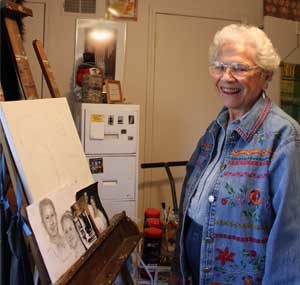

Thanks to a cornea transplant, Anne is able to keep working at her home art studio.
Anne is an artist who resides in Gladstone, Missouri, a municipality in the Kansas City area. Now retired, she focuses on creating artwork for her friends and acquaintances, and she is active in her community as the planning commissioner. In 1980, however, Anne was diagnosed with a hereditary eye disease that causes vision to get worse as an inner layer of the cornea deteriorates. “I went to see my doctor for my yearly exam,” Anne said, “and I was diagnosed with Fuchs’ corneal dystrophy, which, if left untreated, would have blinded me in the left eye.”
For some time, Anne was able to continue her work, both as a teacher and an artist, by keeping routine appointments with her doctor. Together, they could retain her vision by regularly updating the prescription of her glasses. By 2007, however, her doctor finally recommended her to a corneal transplant specialist to fix her vision once and for all. Dr. Tim Cavanaugh of the Cavanaugh Eye Center conducted the operation, replacing the diseased portion of her cornea with corneal tissue donated by a generous donor and their family.
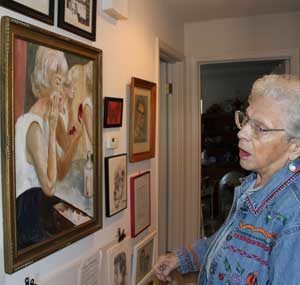
Today, Anne continues to make art, including creating the cover art for Saving Sight’s 2014 holiday card. She is very thankful for the opportunity the transplant has afforded her, both personally and professionally. “I owe so much to the donor, my doctors, and Saving Sight,” she said. “Thanks to the cornea transplant, I can not only see but also continue as an artist.”
To join the millions of Americans who have signed up for the donor registry, register online at Donate Life America or at your local Department of Motor Vehicles office. And be sure to share your decision with your family and friends.
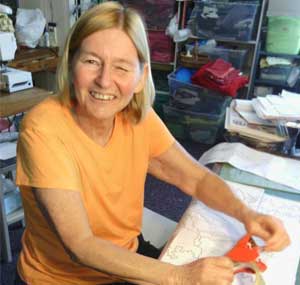
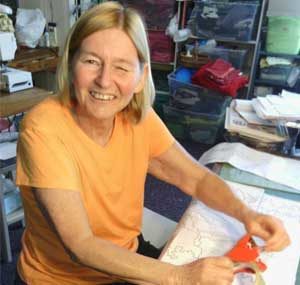
Susan, from Grandview, MO, is back to quilting and her other favorite hobbies thanks to her cornea donors, her surgeon, and Saving Sight.
“Five or six years ago, when I renewed my driver’s license, I almost failed the vision test. They told me I wouldn’t pass the next time,” said Sue of Grandview, Missouri. “So I decided to see an ophthalmologist for an eye exam before my next driver’s test.” However, Sue’s vision problems persisted. “Then one summer, three years ago, I went outside on a very bright day,” she said. “I saw little shards of sparkles in the air. I couldn’t figure out what it was—it was annoying and only happened in the sunlight.” At her doctor’s recommendation, Sue visited Sabates Eye Center in Leawood where she was diagnosed with Fuchs’ corneal dystrophy,a disease that causes the corneas to deteriorate. “The doctors said I was going blind,” Sue remembered. “That’s scary to hear, but they told me it’s a curable disease.” Approximately a year later in August 2013, with the diagnosis of Fuchs’ dystrophy confirmed, Sue received her first corneal transplant, which replaced the diseased part of her cornea.
Sue has experienced vision problems her whole life. As a child, she suffered from amblyopia (“lazy eye”) and had almost no sight in her left eye. She wore a patch over the stronger eye to help strengthen the weak eye, a common treatment for amblyopia. “I started wearing glasses at six years old, and that’s the first time I saw that things have hard lines,” she said.
After her first transplant surgery, Sue admits to feeling impatient and disappointed with the results. “I didn’t know that it takes time for the cells to grow, plus I didn’t get new glasses until after the second transplant in December,” she said. By February or March, after the second surgery, her sight was improving. “At each checkup my sight was a little better,” she said. “I was able to read small font and see better at a distance. I am seeing things I haven’t seen in years.”

Another of Sue’s hobbies is oil painting. Before the transplant surgeries, everything was dark and slightly fuzzy for her. “My teacher asked me why I paint everything so dark,” Sue said. “I told her, ‘I don’t, that’s the way I see it.’ Now, the colors I see are so brilliant. I realized that not a lot of light was getting into my eyes, so I couldn’t see true colors. In the distance, I could not see tree leaves or birds in the sky. The loss was so gradual I didn’t realize for a long time just how bad my sight had gotten.”
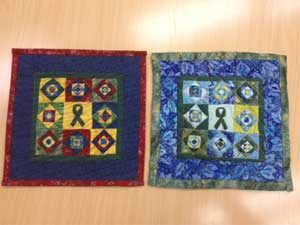
Two miniature quilts Sue gave to Saving Sight as part of her “The Grateful Series.”
With her sight restored, Sue is back to work as a guest service representative at Target and returned to her favorite hobbies: quilting, painting,
reading, gardening, and baking. In fact, she’s currently at work on creating a series of miniature quilts: one for each of her cornea donors’ families, two for Saving Sight, one for her surgeon, Dr. Macaluso, and one for herself. “People have helped me and I wanted to show how grateful I am for their gifts. Now I can continue to enjoy my passion for color through painting and quilting.”
To join the millions of Americans like Suewho signed up for the donor registry, register online at Donate Life America or at your local Department of Motor Vehicles office. And be sure to share your decision with your family and friends.
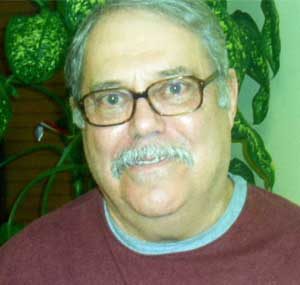

Bill, a retired RN and veteran from Topeka, Kansas, is back to enjoying retirement and his motorcycle after two corneal transplant surgeries.
Bill, a retired operating room RN from Topeka, Kansas, knew he was at-risk to develop Fuchs’ corneal dystrophy. Causing an inner layer of the cornea to blister and cloud, Fuchs’ dystrophy is a hereditary disease, and it ran in his family. Bill’s mother and grandmother had both lost vision to it, but Bill was a full decade younger than they were when he was diagnosed with Fuchs’ dystrophy as well as cataracts. “My vision was cloudy, like looking through lacy curtains or a foggy windshield,” Bill said. Eventually, his sight worsened to 20/600 in both eyes, uncorrected, which left him unable to enjoy one of his favorite hobbies: riding his motorcycle. “I had to curtail that because my vision wasn’t good enough,” he said. “I didn’t feel confident. You have to really pay attention to watch for potential hazards.”
Bill became a nurse after serving in the U.S. Army. Originally in the Kansas Army National Guard, he was activated in May of 1968 and sent to Fort Carson. Later he was sent to Vietnam as a medical corpsman, where he worked in a surgical hospital for six months in the spring and summer of 1969. When offered higher education through the GI Bill, he left Vietnam inspired to enroll in nursing school. “In Vietnam, they had some excellent nurses,” he remembered. “I worked in intensive care there for most of my tour. I always liked being a medical corpsman, helping folks out. I also liked the idea of going to nursing school and being prepared for a specific type of job.”
As it turns out, Bill’s 34 years as a nurse prepared him for his cornea transplant surgeries. “I wasn’t worried about the operation itself,” he said. “I knew they do the surgery under local anesthesia and the patient doesn’t have pain.” What Bill didn’t know, though, was that through an advancement in transplant surgery and eye banking called DSAEK, Saving Sight was able to provide his surgeon with tissue specially prepared for Bill’s unique eye problems. “I wasn’t aware they could do partial-thickness corneal grafts,” he said. In other words, the DSAEK corneal tissue was prepared such that Bill only had to have part of his cornea replaced. “Dr. Cavanaugh, my surgeon, got rid of the diseased endothelial layer of my cornea and transplanted the donor endothelial layer,” Bill explained. This less invasive procedure resulted in a reduced recovery time. “There were no stitches needed,” Bill said. “They put an air bubble in there and you stay laying down for 24 hours while it adhered.” In fact, Bill’s recovery after the first transplant in August 2013 was so successful that he was able to get the second cornea transplant less than three months later.
“It was quite an experience thanks to the kindness of two donors,” Bill said. “I‘m able to see pretty well now.” In fact, Bill has 20/40 vision in both eyes and wears trifocal lenses. So now he gets to better enjoy his well-deserved retirement, including returning to his favorite hobby. “I plan to do some more riding,” he said.
“I bought a new motorcycle. I’ve been holding out for a liquid-cooled, metallic red Harley-Davidson. It should arrive any day now.”
To join the millions of Americans like Bill who signed up for the donor registry, register online at Donate Life America or at your local Department of Motor Vehicles office. And be sure to share your decision with your family and friends.
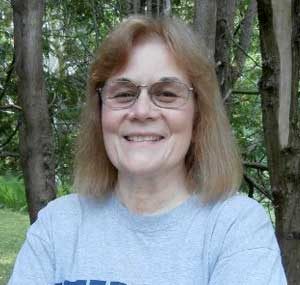

Cheryl, from Frankfort, MI, received two corneal grafts to treat Fuchs’ dystrophy. Without generous cornea donors, she wouldn’t have been able to keep working and enjoying her active lifestyle.
Cheryl is an active 64-year-old from Frankfort, Michigan who grew up on a farm, has been married for 44 years, and has one daughter and three grandchildren. She’s proud of her degree from University of Michigan, and since 1970 she has worked off and on for the Social Security Administration where she helps blind, disabled, and older people file their claims. For 30 years, though, Cheryl has experienced a slow decline in her vision. Eventually, her eyesight reached the point where it could only be corrected to 20/70 with glasses—worse than the legal limit to drive. “I was facing blindness, and most of the things I like to do – read, drive, be outdoors, photography, editing photos – require sight,” she said. Had it not been for corneal transplantation, Cheryl’s vision loss would have prevented her from working and enjoying her active lifestyle.
Cheryl’s mother suffered vision loss due to Fuchs’ dystrophy, a hereditary disease that causes the corneas to cloud over and blister. Unfortunately, Cheryl inherited this disease, too. “In the last two to three years I really noticed my vision loss,” she said. “When you lose something so subtly over a long period of time, you don’t realize what’s going on.” More recently, Cheryl would wake up in the morning with fluid covering her corneas. “When I looked in the mirror, it was clouded over like having the shower on,” she said. “It would clear in an hour or two, but I had to use a hair dryer and drops to get the fluid out. Nothing was sharp, though, and lots of light was irritating.”
In addition to the pain, Fuchs’ dystrophy jeopardized Cheryl’s ability to commute to her job. “I work in Traverse City, about 40 miles one way,” she said. Cheryl would take side roads to avoid higher traffic routes. And when she arrived at work, her vision problems interfered with her job. “I work on a computer screen, and that was getting difficult,” she said.
Last year, after spraining her ankle, Cheryl had a poor response to pain medication that caused the Fuchs’ dystrophy to flare up, significantly reducing her vision in one eye. That was when her ophthalmologist, Dr. Arkin of Traverse City, finally advised a transplant. “We scheduled the surgery for eight weeks later,” Cheryl recalled. Dr. Arkin performed an endothelial keratoplasty, which means only the damaged part of the cornea was replaced and her post-surgery recovery was shorter. “Thankfully Saving Sight had the cornea, and I was there with the need. I got the surgery on Friday, and by Sunday I was seeing better. Two weeks later, I was seeing 20/25 in that eye. It was just really amazing.”
Saving Sight offers recipients and donor families the opportunity to correspond, so Cheryl shared her experience with her donor’s family. “I wanted to let the donor family know how thankful I was,” she said. “That was a moving experience to write a letter to the family articulating what it meant to me and that I know what it meant to them. I am so thankful that people are willing to donate.”
Through blindness, Cheryl also learned more about the people she helps at work. “It gives me insight more so than ever,” she said. “It makes me a better person, knowing what someone goes through when they lose their ability to function.”
Six months later, Cheryl received a transplant on her other eye to replace that cornea, too. “Dr. Arkin did an incredible job with my eyes,” she said. “That transplant healed even more quickly because the eye wasn’t as bad. I feel I was very lucky when everything progressed. All in all, it’s been a positive experience.”
As part of her active lifestyle, Cheryl is planning two hiking trips on South Manitou Island, an island in the northern part of Lake Michigan. “I’m going to take a ferry out to the island and backpack for a couple of days, hauling all my stuff by myself,” she said. “Before surgery, that wouldn’t have been doable because I wouldn’t have felt my sight was good enough to go on my own. Now I can do that, so the transplant has really given me my life back.”
To join the millions of Americans like Cheryl who signed up for the donor registry, register online at Donate Life America or at your local Department of Motor Vehicles office. And be sure to share your decision with your family and friends.